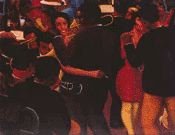
Archibald J. Motley Jr Blues (1929) |
"Like avant-garde movements in Europe, the
Harlem Renaissance embraced all art-forms, including music, dance, film,
theatre and cabaret. Harlem nightlife, with its dance halls and jazz bands,
featured prominently in the work of such artists as Archibald J. Motley
Jr and Aaron Douglas, Miguel Covarrubias, the Mexican painter and illustrator
and the Englishman Edward Burra. Often their focus as on the moving body
of the black performer, sometimes rendered in an exaggerated, almost caricatural,
way. These images are distinguished from caricatures, however, by artists'
sympathetic identification with the aesthetic and cultural values of the
performers and their audience. In a similar fashion, Langston Hughes assimilated
the formal structures of the Blues in his verse. The 'blues aesthetic'
is exemplified in painting by bold, hot colours and improvisatory compostitions,
with a syncopated rhythm of accentuation and suspension, push and pull."
"When, in our own country, black music joined temporarily with modernists visual arts under the banners of sensuous and the immediate it became an important source of resistance against definitions of art to which the opposition between races - re-expressed as conflict between a primitive child and a rational adult - was integral. The music was only able to furnish important analogies for other types of artistic creating - cubism, surrealism - because of the relative ease with which black feeling could be traded as a cultural commodity in a new market. Negrophobia and negrophilia were entangled in some surprising patterns. Harlem became an imaginary repository of transgressive feeling to many far flung affiliates of the avant-garde. Josephine baker and her peers were distinguished emissaries conducting these fantasies into the inner sanctum of European decadence. To the new remote audiences of whom American Harlem was an unproblematic extensions of African tribalism, foregrounding music did little to disrupt their enthusiasm for the exotic and instinctive. black music were enthusiastically reduced to those racial qualities alone. As the music travelled, they registered the processes of dissemination in their own attenuated forms. Some commentators went so far as to suggest that a distinctive Parisian school of jazz playing was developing alongside that practised in New York jazz. European critics began to write about the music seriously and respectfully but without always appreciating its historic ties to black America."
"There was a sharp divergence between those who emphasised that black music was a folk form in transition towards varieties of high cultural expression that could demonstrated the overall worth of the race and others who saw it instead as a sophisticated urban and cosmopolitan phenomenon of an inescapably modernist type. The former view found confirmation in a reading of spirituals while the latter turned instead towards jazz.....In progress towards the elevated destination of classical form, authentic folkstyles unfolded in a marvellous pattern absolutely analogous to that found in the most orthodox accounts of European cultural development. On the other hand, the authority of jazz in the cultural scheme of things was compromised by its inescapably hybrid character. Notwithstanding its energy, jazz, 'sometimes for the better, sometimes not', was becoming 'progressively even more composite and hybridized.' "In Song of the Towers Aaron Douglas perhaps paid the ultimate tribute to the black performing artist, with his commanding image of a black man with a saxophone held high above his head. This figure, rendered in Douglas's tonally graded and silhouetted painting style, functioned within the narrative as the embodiment of the ' New Arts Movement' and the personification of the African American experience up to 1934. As an avatar of black creativity and self-expression, the man with the saxophone is flanked by two other symbolic personae: the great African American migration (in the guise of a running and valise-carrying figure in the lower right corner) and Depression- era apprehension (in the form of a fallen and dazed figure in the lower left corner). All three representations of a twentieth-century African-American experience are depicted by Douglas as standing upon, running on top of, or having fallen off a huge cogwheel, the same symbol of an industrial rat race that Hollywood legend Charles Chaplin would employ in his 1936 film, Modern Times. Extracts from 'Modern Tones' by Paul Gilroy and
Background image of 'Into Bondage' by Aaron Douglas 1936 [Themes] - [Bibliography] - [Home] - [Credits] |
||